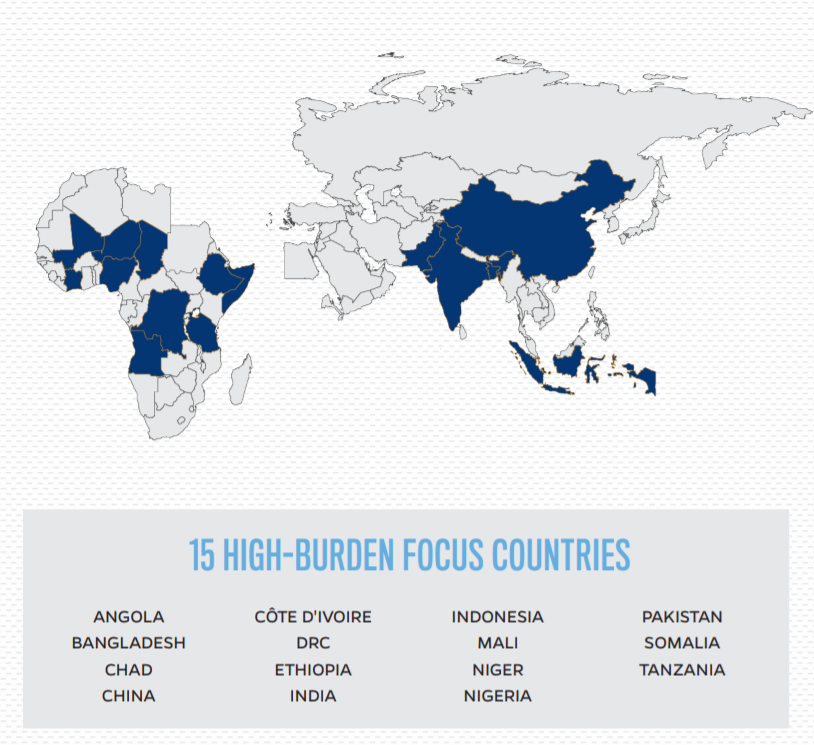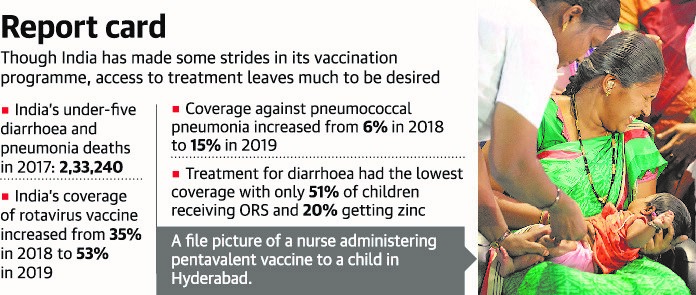Social Justice
Pneumonia and Diarrhoea Progress Report 2020: IVAC
- 16 Nov 2020
- 7 min read
Why in News
Recently, the annual Pneumonia and Diarrhoea Progress Report has been released by the International Vaccine Access Centre (IVAC).
- IVAC, founded in 2009, accelerates equitable access to vaccines through the generation, synthesis, and use of evidence to inform decision-making and action. It is located in the Johns Hopkins Bloomberg School of Public Health, USA.
Key Points
- About the Report:
- It evaluates the progress across 10 high-impact indicators outlined in the Global Action Plan for the Prevention and Control of Pneumonia and Diarrhoea (GAPPD) in the 15 countries with the greatest burden of under-five pneumonia and diarrhoea deaths and how they are delivering key interventions to prevent these.
- These interventions include breastfeeding, immunisation, care-seeking and antibiotics, Oral Rehydration Solution (ORS), and zinc supplementation.
- These measures are proven to help prevent deaths due to these illnesses and could help achieve the Sustainable Development Goal-3 (Good Health and Well-Being) target of reducing under-five mortality to at least as low as 25 per 1,000 live births by 2030.
- In 2009, the World Health Organisation (WHO) and United Nations Children’s Fund (UNICEF) launched the GAPPD, which proposes a multi-sectoral, integrated approach to reduce the incidence of severe pneumonia and diarrhoea, reduce the number of children under-five who are stunted, and end preventable childhood deaths from pneumonia and diarrhoea.
- This year’s report also addresses the emerging impacts of the Covid-19 pandemic.
- It monitors the coverage of five vaccines which are Diphtheria, Pertussis and Tetanus (DPT) vaccine, Measles-containing-vaccine first dose, Haemophilus influenzae type B, pneumococcal conjugate vaccine (PCV), and rotavirus vaccine.
- It evaluates the progress across 10 high-impact indicators outlined in the Global Action Plan for the Prevention and Control of Pneumonia and Diarrhoea (GAPPD) in the 15 countries with the greatest burden of under-five pneumonia and diarrhoea deaths and how they are delivering key interventions to prevent these.
- Global Status:
- Nearly every country included in the report lagged in access to treatments against pneumonia and diarrhoea.
- Overall the world’s health systems are falling short of ensuring that children have access to prevention and treatment services.
- India’s Performance:
- Of the 15 focus countries included in the report, India is one of the countries that exceeded targets for exclusive breastfeeding.
- The World Health Assembly (WHA) has set a target to increase the global rate of exclusive breastfeeding to at least 50% by 2025.
- Exclusive Breastfeeding: It means that the infant receives only breast milk. No other liquids or solids are given, not even water, with the exception of ORS, or drops/syrups of vitamins, minerals or medicines.
- India has made significant progress in its vaccination coverage to prevent child pneumonia and diarrhoea deaths.
- India has achieved the global target of 90% coverage for three of the five vaccines whose coverage is monitored in the report.
- However, India failed to reach all targets for treatment and the treatment for diarrhoea had the lowest coverage, with only 51% of children receiving ORS and 20% getting zinc.
- 90% treatment coverage for children with suspected pneumonia, including care by an appropriate health care provider and antibiotics and 90% treatment coverage for children with diarrhoea, including treatment with ORS and zinc supplements by 2025.
- Although there was progress in India in 2019, the Covid-19 pandemic threatens the gains because of disruptions caused in routine health services like immunisation and access to medical oxygen.
- Of the 15 focus countries included in the report, India is one of the countries that exceeded targets for exclusive breastfeeding.
Diarrhoea
- About:
- It is the passage of 3 or more loose or liquid stools per day, or more frequently than is normal for the individual. There are three clinical types of diarrhoea:
- Acute watery diarrhoea (lasts several hours or days, and includes cholera).
- Acute bloody diarrhoea (also called dysentery).
- Persistent diarrhoea (lasts 14 days or longer).
- It is the passage of 3 or more loose or liquid stools per day, or more frequently than is normal for the individual. There are three clinical types of diarrhoea:
- Causes:
- Diarrhoea is a symptom of infections caused by a host of bacterial, viral and parasitic organisms, most of which are spread by faeces-contaminated water.
- Water contaminated with human and animal faeces is of particular concern. Animal faeces also contain microorganisms that can cause diarrhoea.
- It can also spread from person-to-person, aggravated by poor personal hygiene, food prepared or stored in unhygienic conditions, unsafe domestic water storage and handling.
- Threat:
- The most severe threat posed by diarrhoea is dehydration, which occurs when lost water and electrolytes are not replaced.
- It may be life-threatening, particularly in young children and people who are malnourished or have impaired immunity.
- Prevention and Cure:
- Interventions to prevent diarrhoea, including safe drinking-water, use of improved sanitation and handwashing with soap can reduce disease risk.
- Diarrhoea should be treated with ORS, a solution of clean water, sugar and salt. In addition, nutrient-rich foods and zinc supplemental treatment shortens diarrhoea duration and improves outcomes.
Step Taken by India
- The government aims to achieve a target of reducing pneumonia deaths among children to less than three per 1,000 live births by 2025.
- In 2014, India launched the Integrated Action Plan for Prevention and Control of Pneumonia and Diarrhoea (IAPPD) to undertake collaborative efforts towards prevention of diarrhoea and pneumonia-related under-five deaths.
- Universal Immunization Programme (UIP) was launched by the government in 1985 and prevents mortality and morbidity in children and pregnant women against 12 vaccine-preventable diseases including pneumonia and diarrhoea.
- Social Awareness and Action to Neutralise Pneumonia Successfully (SAANS) Campaign to reduce child mortality due to pneumonia, which contributes to around 15% of deaths of children under the age of five annually.
- In 2019, the government of India launched a rotavirus vaccine drive across all states and Union Territories, which was an unprecedented national scale-up of the rotavirus vaccine.
Way Forward
- National programs to roll-out lifesaving immunizations, such as the rotavirus vaccine in India and the UIP, represent notable achievements. This progress in vaccine introduction and spread is significant to not only reduce morbidity and mortality but also to leverage immunization as a key health system strengthening activity.








